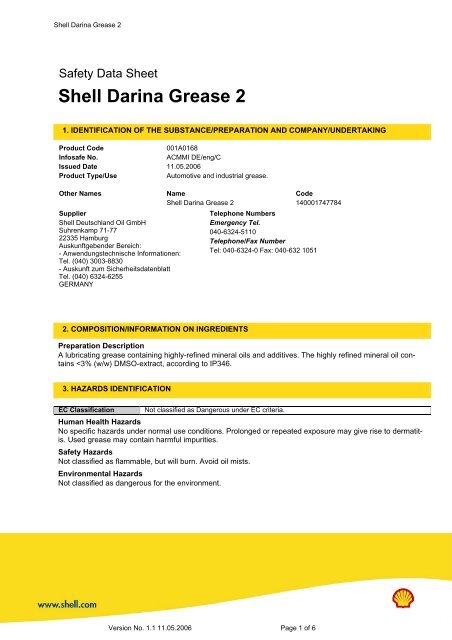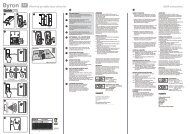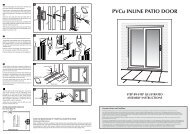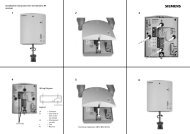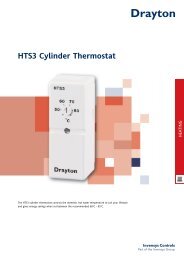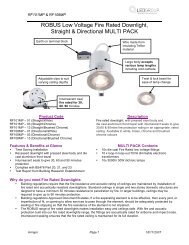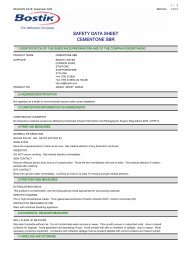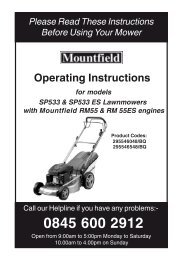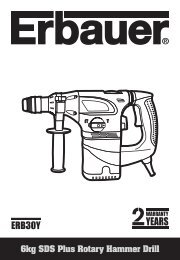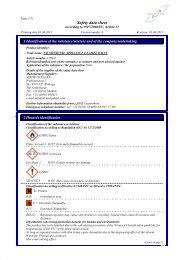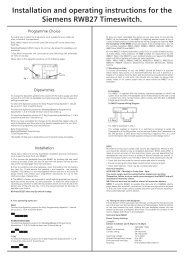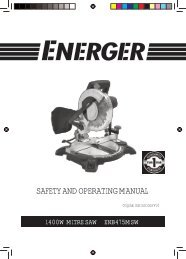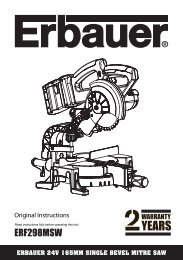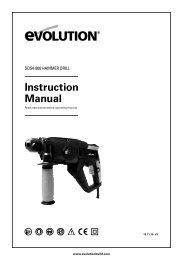Shell Darina Grease 2 - Free-Instruction-Manuals.com
Shell Darina Grease 2 - Free-Instruction-Manuals.com
Shell Darina Grease 2 - Free-Instruction-Manuals.com
You also want an ePaper? Increase the reach of your titles
YUMPU automatically turns print PDFs into web optimized ePapers that Google loves.
<strong>Shell</strong> <strong>Darina</strong> <strong>Grease</strong> 2<br />
Safety Data Sheet<br />
<strong>Shell</strong> <strong>Darina</strong> <strong>Grease</strong> 2<br />
1. IDENTIFICATION OF THE SUBSTANCE/PREPARATION AND COMPANY/UNDERTAKING<br />
Product Code 001A0168<br />
Infosafe No. ACMMI DE/eng/C<br />
Issued Date 11.05.2006<br />
Product Type/Use Automotive and industrial grease.<br />
Other Names Name Code<br />
<strong>Shell</strong> <strong>Darina</strong> <strong>Grease</strong> 2 140001747784<br />
Supplier Telephone Numbers<br />
<strong>Shell</strong> Deutschland Oil GmbH<br />
Suhrenkamp 71-77<br />
22335 Hamburg<br />
Auskunftgebender Bereich:<br />
- Anwendungstechnische Informationen:<br />
Tel. (040) 3003-8830<br />
- Auskunft zum Sicherheitsdatenblatt<br />
Tel. (040) 6324-6255<br />
GERMANY<br />
2. COMPOSITION/INFORMATION ON INGREDIENTS<br />
Emergency Tel.<br />
040-6324-5110<br />
Telephone/Fax Number<br />
Tel: 040-6324-0 Fax: 040-632 1051<br />
Preparation Description<br />
A lubricating grease containing highly-refined mineral oils and additives. The highly refined mineral oil contains<br />
<strong>Shell</strong> <strong>Darina</strong> <strong>Grease</strong> 2<br />
4. FIRST AID MEASURES<br />
Symptoms and Effects<br />
Not expected to give rise to an acute hazard under normal conditions of use.<br />
Inhalation<br />
In the unlikely event of dizziness or nausea, remove casualty to fresh air. If symptoms persist, obtain medical<br />
attention.<br />
Skin<br />
Remove contaminated clothing and wash affected skin with soap and water. If persistent irritation occurs, obtain<br />
medical attention. When using high pressure equipment, injection of product under the skin can occur. If<br />
high pressure injuries occur, the casualty should be sent immediately to a hospital. Do not wait for symptoms<br />
to develop.<br />
Eye<br />
Flush eye with copious quantities of water. If persistent irritation occurs, obtain medical attention.<br />
Ingestion<br />
Wash out mouth with water and obtain medical attention. Do not induce vomiting.<br />
Advice to Doctor<br />
Treat symptomatically. Aspiration into the lungs may result in chemical pneumonitis. Dermatitis may result<br />
from prolonged or repeated exposure. High pressure injection injuries require prompt surgical intervention<br />
and possibly steroid therapy, to minimise tissue damage and loss of function.<br />
5. FIRE FIGHTING MEASURES<br />
Specific Hazards<br />
Combustion is likely to give rise to a <strong>com</strong>plex mixture of airborne solid and liquid particulates and gases, including<br />
carbon monoxide and unidentified organic and inorganic <strong>com</strong>pounds.<br />
Extinguishing Media<br />
Foam and dry chemical powder. Carbon dioxide, sand or earth may be used for small fires only.<br />
Unsuitable Extinguishing Media<br />
Water in jet. Use of halon extinguishers should be avoided for environmental reasons.<br />
Protective Equipment<br />
Proper protective equipment including breathing apparatus must be worn when approaching a fire in a confined<br />
space.<br />
6. ACCIDENTAL RELEASE MEASURES<br />
Personal Precautions<br />
Avoid contact with skin and eyes. Wear PVC, Neoprene or nitrile rubber gloves. Wear rubber knee length<br />
safety boots and PVC Jacket and Trousers. Wear safety glasses or full face shield if splashes are likely to occur.<br />
Environmental Precautions<br />
Prevent from spreading or entering into drains, ditches or rivers by using sand, earth, or other appropriate<br />
barriers. Inform local authorities if this cannot be prevented.<br />
Clean-up Methods - Small Spillages<br />
Dispose into a suitable, clearly marked container for disposal or reclamation in accordance with local regulations.<br />
Clean-up Methods - Large Spillages<br />
As for small spills.<br />
Version No. 1.1 11.05.2006 Page 2 of 6
<strong>Shell</strong> <strong>Darina</strong> <strong>Grease</strong> 2<br />
7. HANDLING AND STORAGE<br />
Handling<br />
Use local exhaust ventilation if there is risk of inhalation of vapours, mists or aerosols. Avoid prolonged or repeated<br />
contact with skin. When handling product in drums, safety footwear should be worn and proper handling<br />
equipment should be used. Prevent spillages. Cloth, paper and other materials that are used to absorb<br />
spills present a fire hazard. Avoid their accumulation by disposing of them safely and immediately. In addition<br />
to any specific re<strong>com</strong>mendations given for controls of risks to health, safety and the environment, an assessment<br />
of risks must be made to help determine controls appropriate to local circumstances.<br />
Storage<br />
Keep in a cool, dry, well-ventilated place. Use properly labelled and closeable containers. Avoid direct sunlight,<br />
heat sources, and strong oxidizing agents.<br />
Storage Temperatures<br />
0ºC Minimum. 50ºC Maximum.<br />
Re<strong>com</strong>mended Materials<br />
For containers or container linings, use mild steel or high density polyethylene.<br />
Unsuitable Materials<br />
For containers or container linings, avoid PVC.<br />
Storage Class<br />
Not Applicable.<br />
Other Information<br />
Polyethylene containers should not be exposed to high temperatures because of possible risk of distortion.<br />
Fire Class<br />
B.<br />
8. EXPOSURE CONTROLS, PERSONAL PROTECTION<br />
Exposure Limits<br />
No Exposure Limit Established<br />
Other Exposure Information<br />
Due to the product's semi-solid consistency, generation of mists and dusts is unlikely to occur.<br />
Exposure Controls<br />
Not applicable.<br />
Respiratory Protection<br />
Respiratory protection is required in the case of oil mists.<br />
Hand Protection<br />
Protective gloves made from PVC or nitrile rubber, so far as safely permissible. The characteristics of the protective<br />
gloves shall be determined by the conditions existing in practice (e.g. multiple use, mechanical loads,<br />
temperature conditions, strength and duration of the exposure which can be expected). Suitability tests by the<br />
user are re<strong>com</strong>mended before selection of appropriate gloves.<br />
Eye Protection<br />
Monogoggles.<br />
Body Protection<br />
Minimise all forms of skin contact. Overalls and shoes with oil resistant soles should be worn. Launder overalls<br />
and undergarments regularly.<br />
Version No. 1.1 11.05.2006 Page 3 of 6
<strong>Shell</strong> <strong>Darina</strong> <strong>Grease</strong> 2<br />
9. PHYSICAL AND CHEMICAL PROPERTIES<br />
Colour Brown.<br />
Physical State Semi-solid at ambient temperature.<br />
Odour Characteristic mineral oil.<br />
pH Value Data not available.<br />
Vapour Pressure Expected to be less than 0.5 Pa at 20°C.<br />
Initial Boiling Point Data not available.<br />
Solubility in Water Negligible.<br />
Density circa 900 kg/m3 at 15ºC.<br />
Flash Point >100ºC (COC).<br />
Flammable Limits - Upper 10% V/V (typical) (based on mineral oil).<br />
Flammable Limits - Lower 1% V/V (typical) (based on mineral oil).<br />
Auto-Ignition Temperature Expected to be above 320ºC.<br />
Kinematic Viscosity Not applicable.<br />
Vapour Density (Air=1) Greater than 1.<br />
Partition co-efficient, n-octanol/water Log Pow expected to be greater than 6.<br />
Dropping Point Data not available.<br />
10. STABILITY AND REACTIVITY<br />
Conditions to Avoid<br />
Extremes of temperature and direct sunlight.<br />
Materials to Avoid<br />
Strong oxidizing agents.<br />
Hazardous De<strong>com</strong>position Products<br />
Hazardous de<strong>com</strong>position products are not expected to form during normal storage.<br />
11. TOXICOLOGICAL INFORMATION<br />
Basis for Assessment<br />
Toxicological data have not been determined specifically for this product. Information given is based on a<br />
knowledge of the <strong>com</strong>ponents and the toxicology of similar products.<br />
Acute Toxicity - Oral<br />
LD50 expected to be > 2000 mg/kg.<br />
Acute Toxicity - Dermal<br />
LD50 expected to be > 2000 mg/kg.<br />
Acute Toxicity - Inhalation<br />
Not considered to be an inhalation hazard under normal conditions of use.<br />
Eye Irritation<br />
Expected to be slightly irritating.<br />
Skin Irritation<br />
Expected to be slightly irritating.<br />
Respiratory Irritation<br />
If vapours are inhaled, slight irritation of the respiratory tract may occur.<br />
Skin Sensitisation<br />
Not expected to be a skin sensitizer.<br />
Version No. 1.1 11.05.2006 Page 4 of 6
<strong>Shell</strong> <strong>Darina</strong> <strong>Grease</strong> 2<br />
Carcinogenicity<br />
Product is based on mineral oils of types shown to be non-carcinogenic in animal skin-painting studies.<br />
Mutagenicity<br />
Not considered to be a mutagenic hazard.<br />
Reproductive Toxicity<br />
Not considered to be toxic to reproduction.<br />
Other Information<br />
Prolonged and/or repeated contact with this product can result in defatting of the skin, particularly at elevated<br />
temperatures. This can lead to irritation and possibly dermatitis, especially under conditions of poor personal<br />
hygiene. Skin contact should be minimised. High pressure injection of product into the skin may lead to local<br />
necrosis if the product is not surgically removed. Used grease may contain harmful impurities that have accumulated<br />
during use. The concentration of such harmful impurities will depend on use and they may present<br />
risks to health and the environment on disposal. ALL used grease should be handled with caution and skin<br />
contact avoided as far as possible.<br />
12. ECOLOGICAL INFORMATION<br />
Basis for Assessment<br />
Ecotoxicological data have not been determined specifically for this product. Information given is based on a<br />
knowledge of the <strong>com</strong>ponents and the ecotoxicology of similar products.<br />
Mobility<br />
Semi-solid under most environmental conditions. Floats on water. If it <strong>com</strong>es into contact with soil, it will<br />
strongly adsorb to soil particles.<br />
Persistence / Degradability<br />
Not expected to be readily biodegradable. Major constituents are expected to be inherently biodegradable,<br />
but the product contains <strong>com</strong>ponents that may persist in the environment.<br />
Bioaccumulation<br />
Contains <strong>com</strong>ponents with the potential to bioaccumulate.<br />
Ecotoxicity<br />
Poorly soluble mixture. May cause physical fouling of aquatic organisms. Product is expected to be practically<br />
non-toxic to aquatic organisms, LL/EL50 >100 mg/l. (LL/EL50 expressed as the nominal amount of product<br />
required to prepare aqueous test extract).<br />
Other Adverse Effects<br />
Not expected to have ozone depletion potential, photochemical ozone creation potential or global warming<br />
potential.<br />
Product is a mixture of non-volatile <strong>com</strong>ponents, which are not expected to be released to air in any significant<br />
quantities.<br />
13. DISPOSAL CONSIDERATIONS<br />
Waste Disposal<br />
Dispose into a suitable, clearly marked container for disposal or reclamation in accordance with local regulations.<br />
The <strong>com</strong>petence of the contractor to deal satisfactorily with this type of product should be established<br />
beforehand. Do not pollute the soil, water or environment with the waste product.<br />
Container Disposal<br />
Recycle or dispose of in accordance with the legislation in force with a recognised collector or contractor.<br />
EU Waste Disposal Code (EWC)<br />
12 01 12 spent waxes and fats.<br />
Classification of waste is always the responsibility of the end user.<br />
Version No. 1.1 11.05.2006 Page 5 of 6
<strong>Shell</strong> <strong>Darina</strong> <strong>Grease</strong> 2<br />
14. TRANSPORT INFORMATION<br />
Transport Information<br />
Not dangerous for transport under ADR/RID, IMO and IATA/ICAO regulations.<br />
15. REGULATORY INFORMATION<br />
EC Symbols None.<br />
EC Risk Phrase Not classified.<br />
EC Safety Phrase Not classified.<br />
EINECS All <strong>com</strong>ponents listed or polymer exempt.<br />
TSCA (USA) All <strong>com</strong>ponents in <strong>com</strong>pliance.<br />
Packaging & Labelling<br />
Safety data sheet available for professional user on request.<br />
Seveso classification<br />
Product is not listed.<br />
Technical Rules Air<br />
Product not listed by name. Observe section 5.2.5 in connection with section 5.4.9.<br />
Water Endangerment Class (WGK)<br />
WGK 2 (VwVwS 5/99, APPENDIX 2).<br />
Volatile Organic Compounds<br />
None.<br />
16. OTHER INFORMATION<br />
Revisions Highlighted<br />
Because of a new system the version number was reset.<br />
References<br />
67/548/EEC - Dangerous Substances Directive.<br />
1999/45/EC - Dangerous Preparations Directive.<br />
91/155/EEC - Safety Data Sheet Directive.<br />
Concawe Report 01/53 - Classification and labelling of petroleum substances according to the EU dangerous<br />
substances directive.<br />
Concawe Report 01/54 - Environmental Classification of Petroleum Substances - Summary Data and Rationale<br />
Concawe Report 05/87 - Health aspects of lubricants.<br />
Restrictions<br />
This product must not be used in applications other than re<strong>com</strong>mended without first seeking the advice of the<br />
SHELL technical department.<br />
Technical Contact Numbers<br />
(040) 3003-8830.<br />
Further Information<br />
This information is based on our current knowledge and is intended to describe the product for the purposes<br />
of health, safety and environmental requirements only. It does not constitute a guarantee for any specific<br />
property of the product.<br />
... End Of SDS ...<br />
Version No. 1.1 11.05.2006 Page 6 of 6


